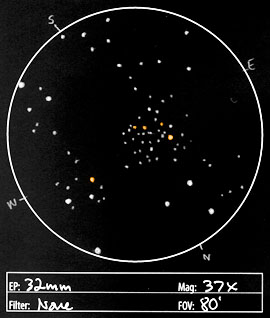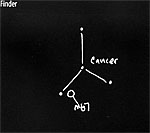
Observation Notes:
 M67 is a nice, subtle open cluster, particularly in comparison to M41 which I viewed earlier in the evening. There is one bright yellow-orange star on the east side of the cluster. There are a few more orange stars scattered around. The main body of the cluster appears to be around 18′ across. The stars seem to keep to an irregular, roundish boundary. I plotted 40 stars in that area, down to mag. 11.7.
M67 is a nice, subtle open cluster, particularly in comparison to M41 which I viewed earlier in the evening. There is one bright yellow-orange star on the east side of the cluster. There are a few more orange stars scattered around. The main body of the cluster appears to be around 18′ across. The stars seem to keep to an irregular, roundish boundary. I plotted 40 stars in that area, down to mag. 11.7.
Factoids:
M67 resides 2,700 light years distant, and is a peculiar open cluster due to its age. Its age is estimated between 3.2 and 4 billion years, and only a few are known to be older. Open clusters usually fly apart much sooner than this. It’s anticipated that M67 can continue to exist as an open cluster for another 5 billion years. This cluster contains at least 500 stars, of which nearly 200 are white dwarfs. Because M67 is of a similar age to the solar system, and its stars have a similar composition to the sun, it is a good target for observation of solar-type stars.
Reportedly, M67 was originally discovered by Johann Elert Bode prior to 1779. Charles Messier rediscovered the cluster in 1780 and resolved it into stars.
| Subject | Messier 67 (NGC 2682) |
| Classification | Open Cluster |
| Position | Cancer [RA: 8:50.4 / Dec: +11:49]* |
| Size* | 30′ |
| Brightness* | 6.1 |
| Date/Time | 01/16/05 – 1:30 AM |
| Observing Loc. | Flagstaff, AZ – Home |
| Instrument | Orion SVP 6LT Reflector (150 mm dia./1200 mm F/L) |
| Eyepieces/Mag. | 32 mm (37X) |
| Conditions | Mostly clear, cold (18°F), some thin high cirrus |
| Seeing | 5/10 |
| Transparency | Mag 5.2 |
*Based on published data.